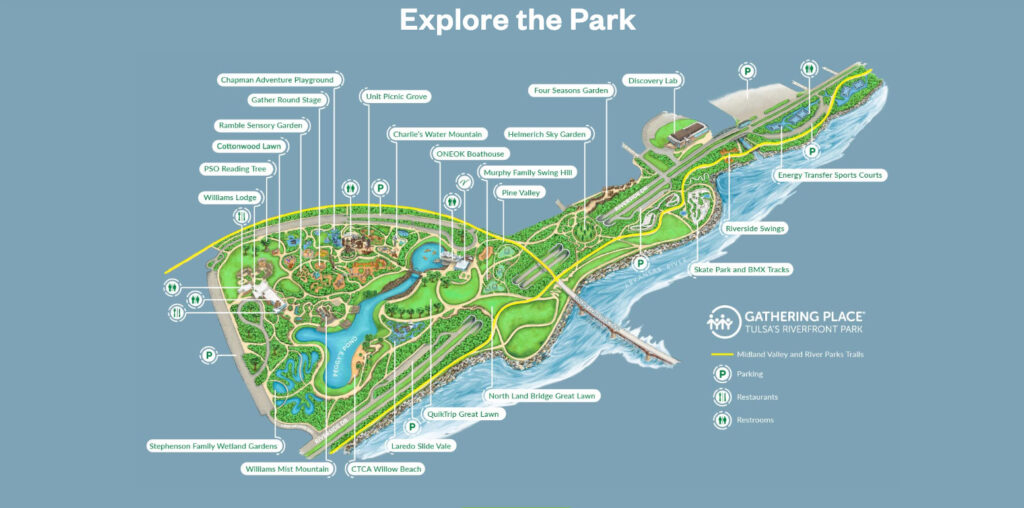
Map of the Gathering Place available at https://www.gatheringplace.org/.
The three remaining survivors of the Tulsa race massacre recently had their case for reparations dismissed in court. As they continue to fight on appeal for the recognition and compensation they deserve, we can turn to Tulsa to see how a community is trying to heal through the creation of communal spaces.Can a city that has arguably epitomized America’s racial trauma as acutely as any other come together a century later to create a space of abundance for all, healing and joy—even as it engages in the necessary work of recognition, remembering and reconciliation?
That is the goal that Tulsa, Oklahoma has set for itself over the past fifteen years. In this city of roughly half a million people, leaders have taken it upon themselves to own up to their legacy: once a thriving community that Booker T. Washington dubbed “Black Wall Street,” in 1921 it became the site of a now infamous race massacre that killed or injured hundreds, burned down the Black neighborhood, and sent community leaders fleeing in an attempt to salvage their lives.
Now, in the 21st century, a variety of efforts, ranging from a series of public forums on reparations to revitalization initiatives—some of them city-sponsored, others public/private ventures, and still others the result of private, corporate or church philanthropy— have focused the collective mind on how to transform this former oil boomtown into a modern and equitable city where everyone belongs. Is that even possible—and if so, what might it take to really make it happen?
According to Jeff Stava, the Chief Operating Officer of the Tulsa Community Foundation, the idea for the Gathering Place dates back to around 2008, when the billionaire philanthropist and proud Tulsa resident wrote his “Fiery Crash memo.” Kaiser was asked to state what his ultimate goals were for the use of his money should he perish in a plane crash. His twenty-page document included a vision for a great urban park. He later summarized the impetus in this way: “Like most cities, Tulsa has become siloed over the years by geography, occupation, economic status, and race, and there’s little true sense of community. What we’re trying to do is to create a place where people from different backgrounds and experience gather and really get to know each other.”
A 2007 bond measure to create parks along the little used Arkansas River shore had shown there wasn’t a public appetite to invest tax dollars in shared recreational spaces, so Kaiser quietly and methodically took it upon himself to do so, investing fifty million dollars in knitting together large and small parcels of land until he had accumulated a 100-acre riverside lot. The Gathering Place opened ten years later, with a 5-acre Adventure Playground—a free, Harry Potter-worthy world-class exploration environment with climbing structures, bridges, castles and tunnels—a lake, an ultramodern boathouse with exhibition space, free canoes, kayaks and paddle-boats for public checkout, a great lawn for outdoor concerts, a “Reading Tree,” a beach, and a high-design lodge worthy of a ski resort, with free Wi-Fi, a café, and colorful, comfortable furniture, where people can work remotely in air-conditioned comfort or bring their kids for story time on a scalding hot day.
The entire park is free and open year-round to the Tulsa community and their visitors. The place feels magical. It exceeds expectations for what an urban park can be, but as Jeff Stava is quick to point out: “The most important part of the park isn’t the park itself. The most important part is that it’s programmed in a manner that everyone feels that it’s theirs.” Activation is key: “We focus on making events and programming that everyone can participate in,” Stava states. In a city that has both Red and Blue constituencies, they avoid the cultural polemics du jour. And while most of the events have been programmed by the staff, Community Engagement Officer Kyra Carby asks the participation and co-design question: “How can we create spaces where people can come in and program as well?” This spring, she began a series of “Global Gatherings” every Friday for thirteen weeks, where the Gathering Place holds space for communities of all ethnicities to “show up as themselves” and present their cultures.
It is a place where people can feel human across identity boundaries that might keep them apart elsewhere in the city—across zip codes, races, income and educational levels. The Gathering Place also plays a role in its encouragement of child literacy, and the delivery of stacked services such as health screenings, COVID vaccinations, and coaching in parenting skills.
If identity is context-dependent and situational, can we create a context that brings people together and does not Other? If bitterness and grievance beget division and othering, can generosity forge a sense of a larger “we” that works for all? That seems to be the wager of the Gathering Place. It proposes a surplus, not a deficit: an expanding, generous circle in lieu of a zero-sum game.
